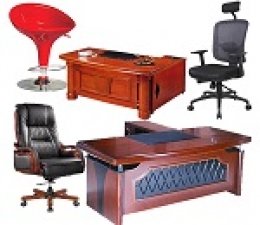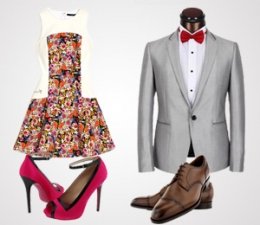CHAIRS
A chair is a piece of furniture with a raised surface commonly used to seat a single person. Chairs are supported most often by four legs and have a back; however, a chair can have three legs or could have a different shape. Chairs are made of a wide variety of materials, ranging from wood to metal, and they may be padded or upholstered, either just on the seat or on the entire chair (e.g., with a La-Z-Boy chair). Chairs are used in a number of rooms in homes (e.g., in living rooms, dining rooms and dens), in schools and offices (with desks) and in various other workplaces.
A chair without a back or arm rests is a stool, or when raised up, a bar stool. A chair with arms is an armchair and with upholstery, reclining action and a fold-out footrest, a recliner. A permanently fixed chair in a train or theater is a seat or, in an airplane, airline seat; when riding, it is a saddle and bicycle saddle, and for an automobile, a car seat or infant car seat. With wheels it is a wheelchair and when hung from above, a swing.
An upholstered, padded chair for more than one person is a couch, sofa, settee, or "loveseat"; or if is not upholstered, a bench. A separate footrest for a chair, usually upholstered, is known as an ottoman, hassock or pouffe
HISTORY
The chair has been used since antiquity, although for many centuries it was a symbolic article of state and dignity rather than an article for ordinary use. "The chair" is still used as the emblem of authority in the House of Commons in the United Kingdom and Canada, and in many other settings. In keeping with this historical connotation of the "chair" as the symbol of authority, committees, boards of directors, and academic departments all have a 'chairman' or 'chair'. Endowed professorships are referred to as chairs.
It was not until the 16th century that chairs became common. Until then, people sat on chests, benches and stools, which were the ordinary seats of everyday life, and the number of chairs which have survived from an earlier date is exceedingly limited; most examples are of ecclesiastical or seigneurial origin. Our knowledge of the chairs of remote antiquity is derived almost entirely from monuments, sculpture and paintings.
Chairs were in existence since at least the Early Dynastic Period of Egypt. They were covered with cloth or leather, were made of carved wood and were much lower than today’s chairs, chair seats were sometimes only 25 cm high. In ancient Egypt chairs appear to have been of great richness and splendor. Fashioned of ebony and ivory, or of carved and gilded wood, they were covered with costly materials, magnificent patterns and supported upon representations of the legs of beasts or the figures of captives. Generally speaking, the higher ranked an individual was, the taller and more sumptuous was the chair he sat on and the greater the honor. On state occasions the pharaoh sat on a throne, often with a little footstool in front of it.
The earliest images of chairs in China are from sixth-century Buddhist murals and stele, but the practice of sitting in chairs at that time was rare. It was not until the twelfth century that chairs became widespread in China. Scholars disagree on the reasons for the adoption of the chair. The most common theories are that the chair was an outgrowth of indigenous Chinese furniture, that it evolved from a camp stool imported from Central Asia, that it was introduced to China by Christian missionaries in the seventh century, and that the chair came to China from India as a form of Buddhist monastic furniture. In modern China, unlike Korea or Japan, it is no longer common to sit at floor level.
In Europe, it was owing in great measure to the Renaissance that the chair ceased to be a privilege of state, and became a standard item of furniture for anyone who could afford to buy it. Once the idea of privilege faded the chair speedily came into general use. We find almost at once that the chair began to change every few years to reflect the fashions of the day.
In the 1880s, chairs became more common in American households and usually there was a chair provided for every family member to sit down to dinner. By the 1830s, factory-manufactured “fancy chairs” like those by Sears. Roebuck, and Co. allowed families to purchase machined sets. With the Industrial Revolution, chairs became much more available.
The 20th century saw an increasing use of technology in chair construction with such things as all-metal folding chairs, metal-legged chairs, the Slumber Chair, moulded plastic chairs and ergonomic chairs. The recliner became a popular form, at least in part due to radio and television.
The modern movement of the 1960s produced new forms of chairs: the butterfly chair (originally called the Hardoy chair), bean bags, and the egg-shaped pod chair that turns. Technological advances led to molded plywood and wood laminate chairs, as well as chairs made of leather or polymers. Mechanical technology incorporated into the chair enabled adjustable chairs, especially for office use. Motors embedded in the chair resulted in massage chairs.
Materials
Chairs can be made from wood, metal, or other strong materials. In some cases, multiple materials are used to construct a chair; for example, the legs and frame may be made from metal and the seat and back may be made from plastic. Chairs may have hard surfaces of wood, metal, plastic, or other materials, or some or all of these hard surfaces may be covered with upholstery and/or padding. The design may be made of porous materials, or be drilled with holes for decoration; a low back or gaps can provide ventilation. The back may extend above the height of the occupant's head, which can optionally contain a headrest. Chairs can also be made from more creative materials, such as recycled materials like cutlery and wooden play bricks, pencils, plumbing tubes, rope and PVC pipe.
In rare cases, chairs are made out of unusual materials. Raimonds Cirulis, a Latvian interior designer, created a volcanic hanging chair that is a handmade out of volcanic rock. Peter Brenner, a Dutch-born German designer, has created a chair made from lollipop sugar, made from 60 pounds of confectioners' sugar.
Design and ergonomics
Chair design considers intended usage, ergonomics (how comfortable it is for the occupant), as well as non-ergonomic functional requirements such as size, stacking ability, folding ability, weight, durability, stain resistance, and artistic design. Intended usage determines the desired seating position. "Task chairs," or any chair intended for people to work at a desk or table, including dining chairs, can only recline very slightly; otherwise the occupant is too far away from the desk or table. Dental chairs are necessarily reclined. Easy chairs for watching television or movies are somewhere in between depending on the height of the screen.
A reclining seat and back will shift weight to the occupant's back. This may be more comfortable for some in reducing weight on the seat area, but may be problematic for others who have bad backs. In general, if the occupant is supposed to sit for a long time, weight needs to be taken off the seat area and thus "easy" chairs intended for long periods of sitting are generally at least slightly reclined. However, reclining may not be suitable for chairs intended for work or eating at table.
A chair may or may not have armrests; chairs with armrests are termed "armchairs". In French, a distinction is made between fauteuil and chaise, the terms for chairs with and without armrests, respectively. If present, armrests will support part of the body weight through the arms if the arms are resting on the armrests. Armrests further have the function of making entry and exit from the chair easier (but from the side it becomes more difficult). Armrests should support the forearm and not the sensitive elbow area. Hence in some chair designs, the armrest is not continuous to the chair back, but is missing in the elbow area.
A couch, bench, or other arrangement of seats next to each other may have armrest at the sides and/or arm rests in between. The latter may be provided for comfort, but also for privacy (e.g. in public transport and other public places), and to prevent lying down on the bench. Arm rests reduce both desired and undesired proximity. A loveseat in particular, has no armrest in between two seating positions.
Chair seats vary widely in construction and may or may not match construction of the chair's back (backrest).
Some systems include:
Center seats where a solid material forms the chair seat
Solid wood, may or may not be shaped to human contours
Wood slats, often seen on outdoor chairs
Padded leather, generally a flat wood base covered in padding and contained in soft leather
Stuffed fabric, similar to padded leather
Metal seats of solid or open design
Molded plastic
Stone, often marble
Open center seats where a soft material is attached to the tops of chair legs or between stretchers to form the seat
Wicker, woven to provide a surface with give to it
Leather, may be tooled with a design
Fabric, simple covering without support
Tape, wide fabric tape woven into seat, seen in lawn chairs and some old chairs
Caning,
Rush, wrapped from rush, heavy paper, strong grasses, or hand twisted while wrapped with cattails to form the seat, usually in a pattern of four trapezoids meeting in the center, and on rare occasions, in elaborate patterns
Reed,
Rawhide
Splint, ash, oak or hickory strips are woven
Metal, Metal mesh or wire woven to form seat
Get the quality chairs for home and office use at Deluxe online store.Shop with us for the best furniture that fits your life style.







